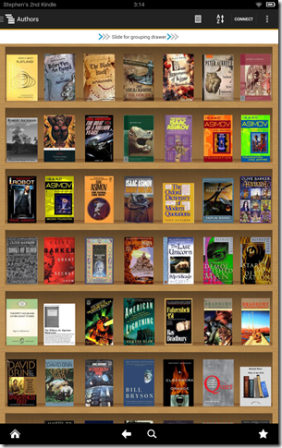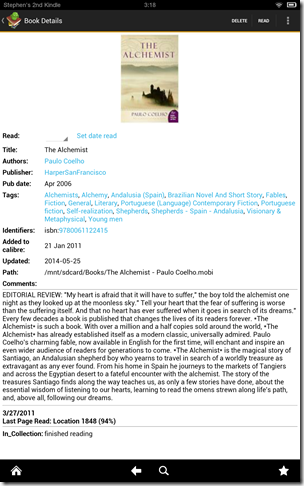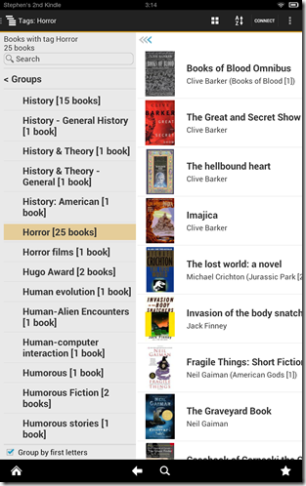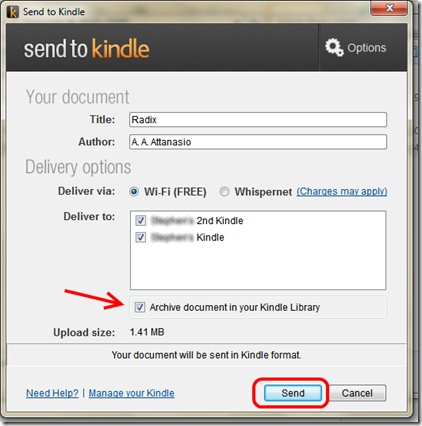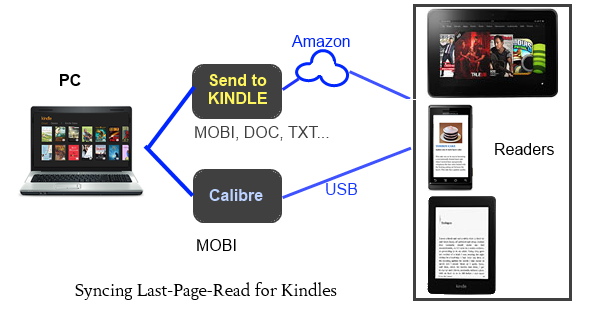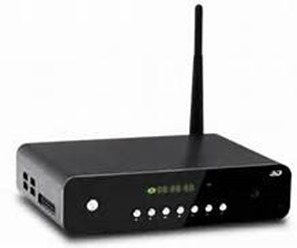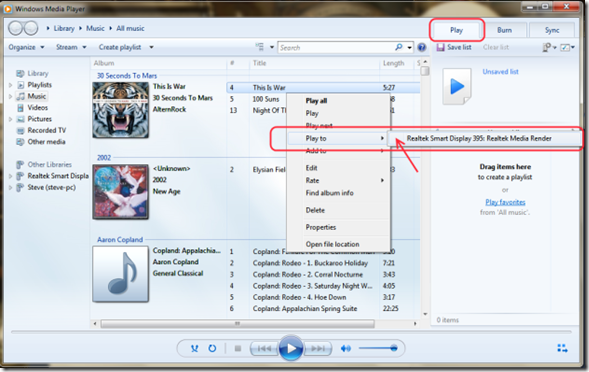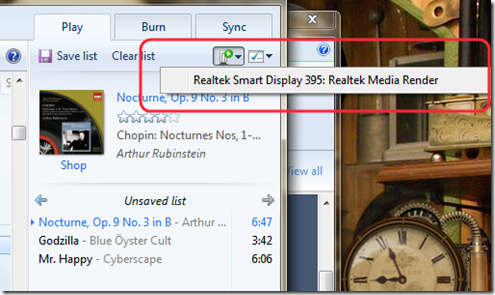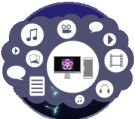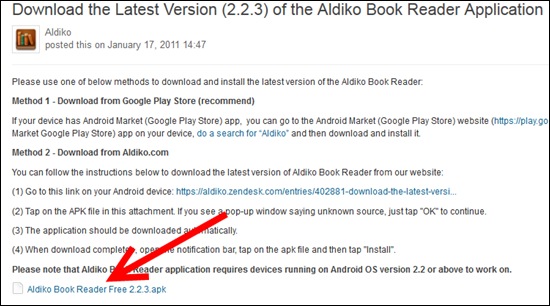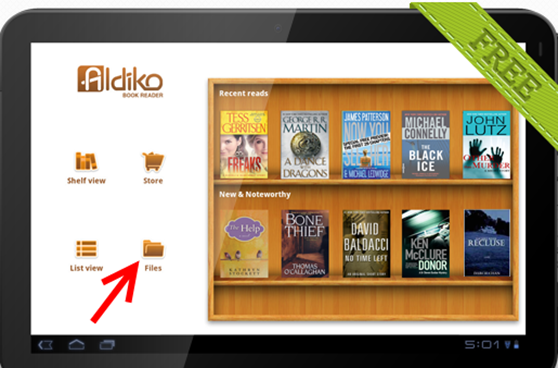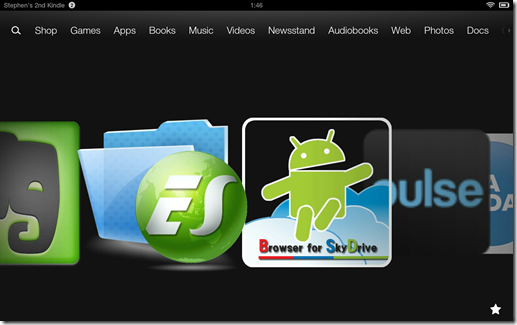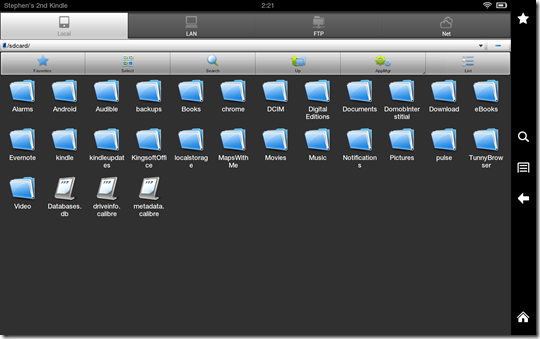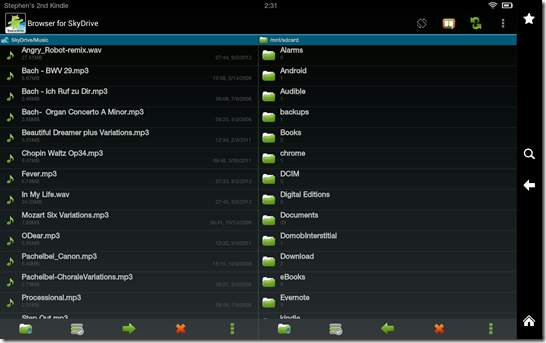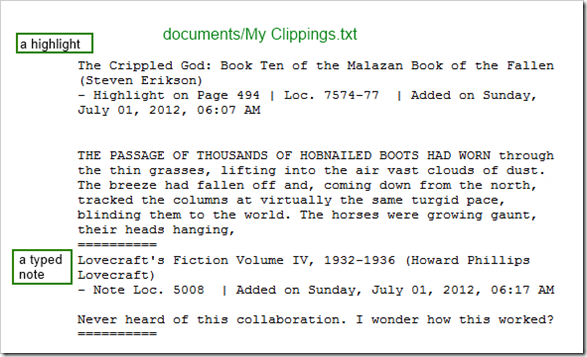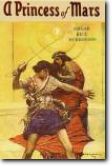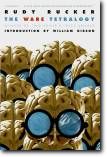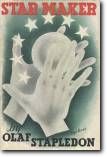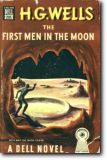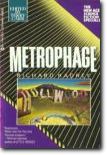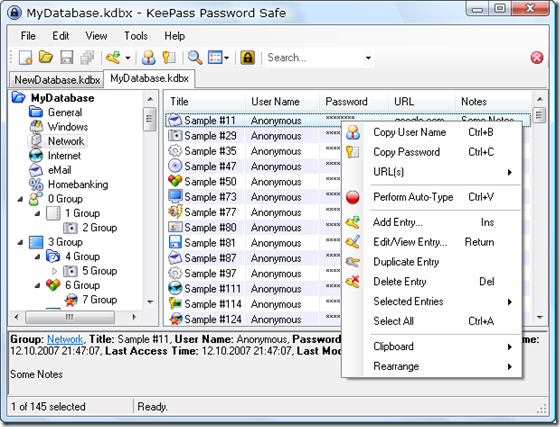First Steps (wireless & e-mail)
First setup your wireless connection on the Kindle. On the home screen (tap the little house icon at bottom left to go there) swipe your finger down from the top of the screen to reveal the settings page. Tap Wireless and a list of wireless networks around you will be shown. 1 Tap your network in the list, enter the Wi-Fi network password and tap Connect.
Next setup your e-mail accounts. Tap the Home icon and swipe down from the top again to get the Settings screen. If you don’t see a heading of “Settings” followed by a list, tap the More icon which looks like a plus sign inside a white circle. Tap My Account. Tap Manage E-mail, Contacts, Calendars. Tap Add Account and choose your email provider from the next screen. Enter your e-mail address and password using the on-screen keyboard.2 Add more accounts if you have them.
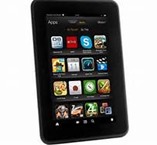 1 The Kindle Wireless setting must be “ON” — if you have a hidden network that’s not shown in the list, (you chose to not broadcast the network SSID from your router) then you need to choose the Add Network + choice and enter a network ID and password.
1 The Kindle Wireless setting must be “ON” — if you have a hidden network that’s not shown in the list, (you chose to not broadcast the network SSID from your router) then you need to choose the Add Network + choice and enter a network ID and password.
2 If you need capital letters tap the “up arrow” key to shift. For numbers and symbols tap the “?123” key (tap the “ABC” key to go back to letters). Tap the “Next” button to go to the next field in the entry form.
Tip: If you are ever on a screen where the home icon is hidden, you can get it back by a single tap at the bottom center of the screen.
Amazon Prime
You get one month of the Amazon Prime service for free when you registered your Kindle Fire HD. This entitles you to free 2-day shipping from amazon.com and several other services. After a month you’ll have to decide if you want to pay for an annual subscription.
 You can “Shop” on amazon.com for Amazon Instant Video (shown as a Prime Instant Video) and stream them to your Kindle Fire HD for free. If you have a Roku media streamer or smart TV you can use its Amazon Instant Video app to stream movies and TV shows to your home theater.1 You can “buy” one free “qualifying (Amazon.com Prime)” e-book per month as part of the service. There is also a Kindle Owners Lending Library where you can borrow a book for 30 days. For simplicity, “Amazon Prime” is a separate shopping category on the amazon.com site.
You can “Shop” on amazon.com for Amazon Instant Video (shown as a Prime Instant Video) and stream them to your Kindle Fire HD for free. If you have a Roku media streamer or smart TV you can use its Amazon Instant Video app to stream movies and TV shows to your home theater.1 You can “buy” one free “qualifying (Amazon.com Prime)” e-book per month as part of the service. There is also a Kindle Owners Lending Library where you can borrow a book for 30 days. For simplicity, “Amazon Prime” is a separate shopping category on the amazon.com site.
1 An alternative is to buy a mini-HDMI to HDMI cable to plug your Kindle Fire HD into your TV’s HMDI port to watch and listen to your content on the home theater system.
Tip: If you do nothing else, get your free e-book before this offer expires.
Apps for Kindle Fire HD
There are already apps on your device and they are worth checking out. You already setup the e-mail app and if you went to the Amazon store you were using the Shop Amazon app. The Amazon AppStore for Android has thousands of paid and free apps that will work fine on your device. And it offers one (normally paid app) for free each day.
 But first, a warning. Some Amazon apps on the site look to be things you’d want on your Kindle Fire HD (for instance, the Kindle Reader and Kindle AppStore apps) but these are already built-in to your device. They are offered in the store for users of Android phones or tablets which don’t have them built-in. Also, lamentably, many free apps are so riddled with ads and offers for paid upgrades that they are unusable. It’s OK to try them for a while then uninstall them1 when you can’t stand them anymore.
But first, a warning. Some Amazon apps on the site look to be things you’d want on your Kindle Fire HD (for instance, the Kindle Reader and Kindle AppStore apps) but these are already built-in to your device. They are offered in the store for users of Android phones or tablets which don’t have them built-in. Also, lamentably, many free apps are so riddled with ads and offers for paid upgrades that they are unusable. It’s OK to try them for a while then uninstall them1 when you can’t stand them anymore.
And finally, many (most?) of the apps are designed for smart phones and their display doesn’t take advantage of the screen on an HD tablet. Look for apps that have “HD” in the name or say “for Kindle Fire”. Read some of the user comments and see if it’s worked well on the Kindle Fire HD. It’s still not a foolproof method, but it improves your chances of actually liking the app.
1 To uninstall an app: from the home screen tap Apps on the header bar. On the Apps screen tap the “Device” button at the top center. Scroll to find the app to uninstall. Long-press the app icon and tap “Remove from Device” in the pop-up menu. You may have to confirm this action.
Tip: When you purchase an app on the store it is sent wirelessly to your Kindle, so be sure you have wireless turned on to receive the app.
Recommended Free Apps
- Your local TV news station (search the AppStore for “tv news”)
- ES File Explorer (manage & play files on your device or network)
- DuckDuckGo Search (a Google alternative that saves nothing about you)
- Evernote (organizes and creates notes and reminders)
- Mahjong Deluxe HD Free (game)
- NeoCal Lite Calculator (scientific calculator with history list)
- News Republic (a news aggregator with pictures)
- Avia Media Player (play media and can send to a media renderer wirelessly)
- Sudoku Free (game, set your difficulty – tiny ads)
- The Weather Channel for Android (local weather, maps, videos – fast)
Other Apps
Explore what you can get that lets your Kindle interact with your services at home. For instance if you are a Netflix subscriber try the Netflix app. I have apps that interact with my media streaming box and an app that interacts with my PC music studio. You may find an app that lets you use your Kindle as a remote control. One of the apps that comes pre-installed on the Kindle Fire HD is Skype. Microsoft recently bought Skype as a replacement for Microsoft Messenger. Text messages and video calls are free for Skype-to-Skype messaging.
Other Considerations
Your device is Bluetooth-capable so you can use a Bluetooth wireless keyboard with it.1 Hard plastic covers are available which offer some protection. Some apps (like drawing/sketching, crossword games) work a lot easier if you use a stylus designed for touch screens. If you have media you want to transfer to your device from your PC or network you can either hook it up with the USB cable (and copy mp3 music files to the Kindle music folder, for example) or you could use the ES File Explorer app to wirelessly transfer files from public network sources.
There is a lot more you can do to customize your experience in the Settings, but I leave that for you to discover.
1 There is a Bluetooth setup in the Settings list.
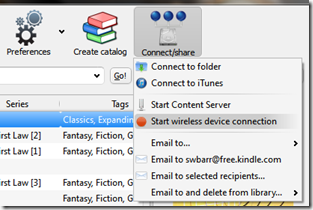 Inside Calibre on my computer, I added the “Connect/share” choice to the main toolbar. Now I can use it to “Start a wireless device connection” and press the “Connect” button in the CC app running on the Kindle Fire HD. If it’s successful the Kindle shows up as an active device in Calibre and I can use the regular “Send to Device” commands to send books or see books on the Kindle without a wired connection. This feature and the library off-line sorting and browsing make the Calibre Companion app worth the money.
Inside Calibre on my computer, I added the “Connect/share” choice to the main toolbar. Now I can use it to “Start a wireless device connection” and press the “Connect” button in the CC app running on the Kindle Fire HD. If it’s successful the Kindle shows up as an active device in Calibre and I can use the regular “Send to Device” commands to send books or see books on the Kindle without a wired connection. This feature and the library off-line sorting and browsing make the Calibre Companion app worth the money.
